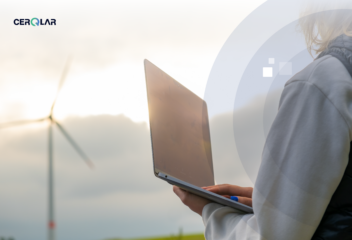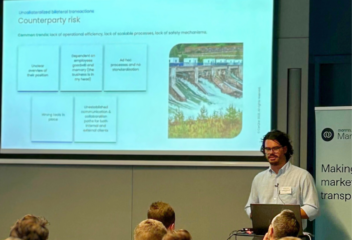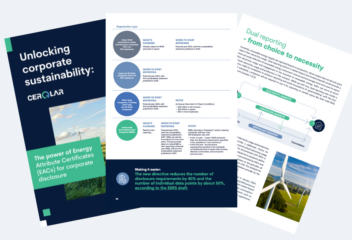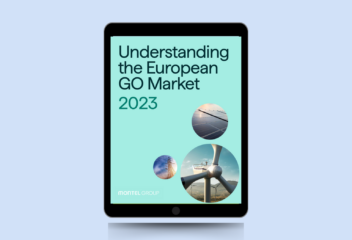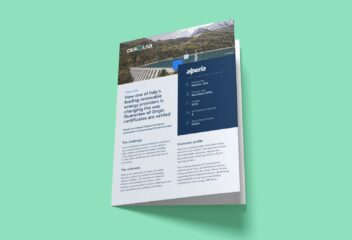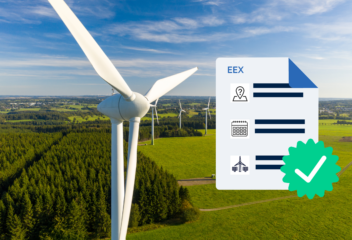The Ripple Effect: How GoO Prices Influence PPA Pricing in the Renewable Energy Market
In the pursuit of a greener future, the renewable energy sector has seen remarkable growth. In an era where governments, businesses, and individuals worldwide are prioritizing the reduction of carbon emissions and seeking sustainable alternatives, Guarantees of Origin certificates(GoOs) serve as a testament to the authenticity of renewable energy sources. This article delves into the critical interplay between GoO prices and Power Purchase Agreement (PPA) pricing.
It aims to shed light on their far-reaching impacts on the renewable energy market – including how they can serve as vital tools in mitigating risks associated with market volatility.
Let’s explore these dynamics.

The vital role of Guarantees of Origin
Guarantees of Origin certificates have emerged as linchpins in the renewable energy landscape. They not only authenticate the origin of renewable energy generation but also instill trust in consumers and investors alike.
As nations strive to meet ambitious climate goals, GoOs enable them to do so. Within this transformative landscape, GoOs play a significant role in power purchase agreements (PPAs), bridging the gap between renewable energy producers and consumers while increasing traceability. They also address vital environmental and regulatory aspects, ensuring that the energy being consumed is truly sustainable.
Read more: Your Guide to Guarantees of Origin.
Unpacking corporate PPAs: physical vs. virtual contracts
A corporate Power Purchase Agreement (PPA), in essence, is a long-term contractual arrangement between a corporate purchaser and a renewable energy generator, ensuring a supply of renewable electricity supported by Guarantees of Origin (GOs). These agreements play a vital role in the renewable energy industry by offering a mechanism for renewable energy projects to obtain long-term financing. This is achieved by ensuring a predetermined price for the electricity generated throughout the contract’s duration.
Corporate PPAs typically take two forms:
- Physical PPAs: Contracts involving the actual delivery of power, with both parties situated on the same national or regional grid. A third-party intermediary is often engaged to handle the transmission of the generator’s energy, along with any remaining physical energy requirements through a sleeving arrangement.
- Virtual PPAs: In the case of Virtual PPAs, the corporate buyer is interested in purchasing renewable GoOs to substantiate their “clean” energy claims. These agreements operate through financial contracts where the price of the underlying electricity is settled using a Contract-for-Difference (CfD) structure.
The only physical exchange involves the transfer of GoOs. There is no direct transmission of energy between the corporate buyer and the renewable generator. The renewable energy is supplied to the generator’s grid independently of the energy consumed by the corporate purchaser. Virtual PPAs (for GoOs) facilitate pan-European cross-border agreements, particularly when the buyer and supplier are located in different countries.
In all PPA structures, generators combine their Guarantees of Origin with the renewable electricity supply to authenticate the corporate buyer’s renewable consumption. The monetary worth of these GoOs is factored into the negotiated PPA price agreed upon by the parties involved.
While corporate Power Purchase Agreements (PPAs) are presently viewed as the top-tier approach to corporate renewable energy procurement, there exists a spectrum of PPA types with differing implications. It is expedient to categorize PPAs into two main groups: those involving new assets, and Lifetime Extension PPAs.
The nexus: GoO prices and PPA pricing
The pricing structure of PPAs is influenced by a range of factors, including the cost of producing the electricity, the cost of financing the project, and the value of GoOs. When GoO prices rise, renewable energy projects gain additional revenue by selling these certificates. This, in turn, can reduce the cost of electricity, making renewable energy projects more competitive in the market.
A multitude of elements converge to determine GoO prices, consequently shaping the renewable energy market dynamics. Supply and demand, government policies, renewable energy penetration, geographical considerations, and the maturity of regulatory frameworks all play pivotal roles.
Let’s unpack these factors in further detail:
- Supply and demand dynamics:
As with any other market, the principle of supply and demand plays a significant role in determining GoO prices. Shifting economic, social, and political dynamics can all affect the demand for renewable energy, leading to changes in GoO prices.
- Government policies and regulations:
GoO prices are impacted by supportive policies that incentivize renewable energy generation. Policies like feed-in tariffs, renewable portfolio standards, and renewable energy targets create a higher demand for GoOs, driving prices up. Additionally, changes in regulatory frameworks or the introduction of new market mechanisms can influence GoO prices by altering the supply-demand dynamics.
- Renewable energy penetration:
Regional variations in GoO prices are observed across Europe due to differences in the level of renewable energy penetration. Countries with a higher share of renewable energy in their energy mix tend to have higher GoO prices. This is because the demand for GoOs is typically higher in regions with a stronger commitment to renewable energy.
- Geographic and energy form considerations:
Factors such as the geographic location and the specific form of renewable energy also impact GoO prices. For example, regions with abundant solar resources may have higher GoO prices for solar-generated energy. Similarly, the price of GoOs for wind energy can vary based on the wind resources available in a particular area. These geographic and energy form considerations contribute to the regional variations in GO prices.
- Regulatory frameworks and market maturity:
Regional variations in GoO prices also stem from differences in regulatory frameworks and the maturity of renewable energy markets. Countries with well-established and mature renewable energy markets often have stronger support mechanisms and regulations, which can contribute to higher GoO prices.
Understanding these factors allows stakeholders to make informed decisions regarding their renewable energy investments.
The impact of green initiatives on GoO pricing and PPA benefits
In Europe, a growing number of countries are adopting ambitious green initiatives like RE100, demonstrating a strong commitment to reducing their carbon footprint. This has driven a notable increase in demand for GoOs. A recent analysis by Ecohz, a global sustainability solutions provider, revealed that by the end of 2022, GoO prices had surged to over 9 EUR/MWh, a substantial rise from the 1.7 EUR/MWh prices in January 2022.
High GoO prices generate additional revenue, lower electricity production costs, and increase project competitiveness. GoOs provide stable revenue streams, attracting financing and reducing project risks, making PPAs with GoOs more attractive to investors and lenders. Anticipating future GoO price trends is thus essential. Stakeholders should monitor regulatory frameworks, promote market transparency, and streamline administrative procedures to drive down GoO prices and accelerate renewable energy adoption.



